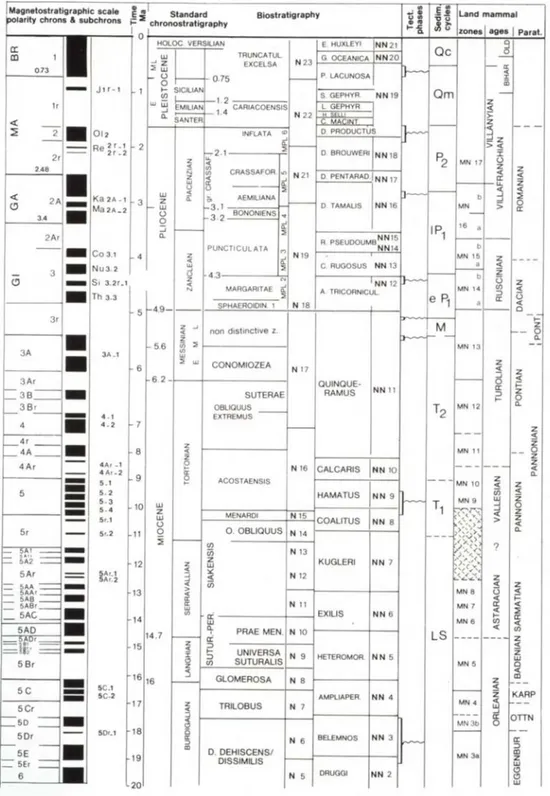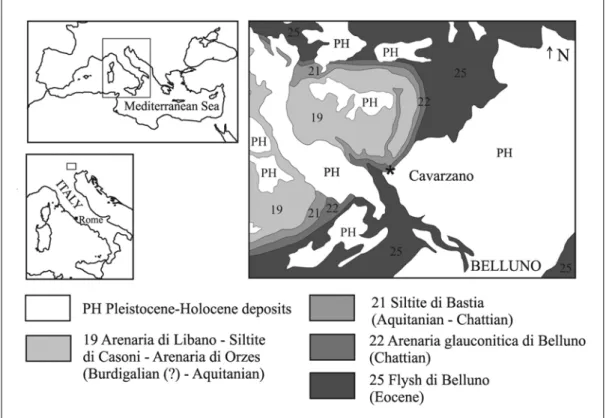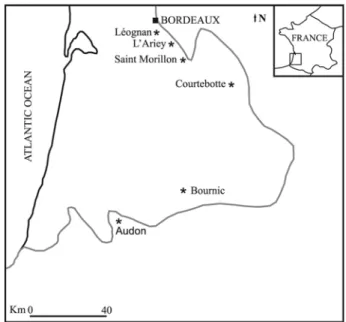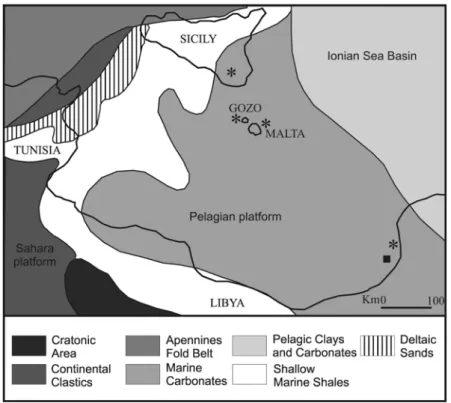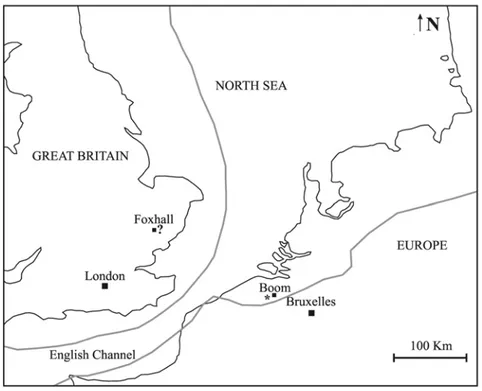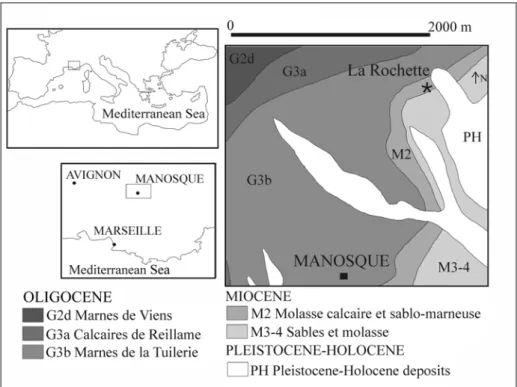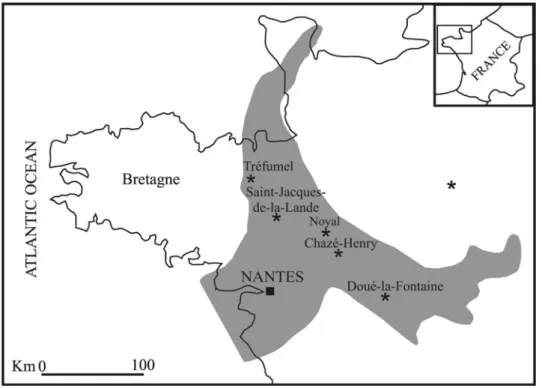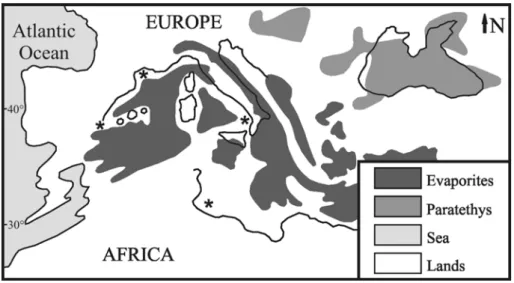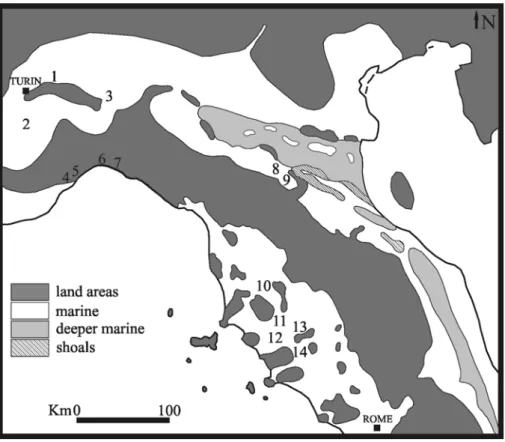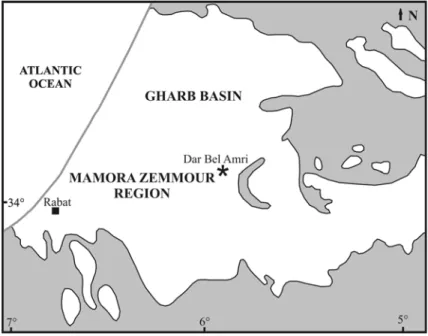CHAPTER 3
GEOLOGICAL SETTING
3.1 INTRODUCTION
In this chapter I give a better chronostratigraphic setting of the Neogene Euro-North African sirenian species and of the Late Oligocene “Halitherium” bellunense, previously referred to the Early Miocene.
I include also the indeterminate fragmentary specimens in order to obtain a complete geographic and chronostratigraphic distribution of the sirenians along the Euro-North African coasts during the Neogene.
Particular attention is given to the supposed first and last occurrence of each species in order to better calibrate the range of each species. For some Pliocene Italian specimens, foraminiferal analyses were carried out by Dr. Vaiani (Dipartimento di Scienze della Terra e Geologico-Ambientali, Università di Bologna, Italy), in order to establish the last sirenian occurrence in the Mediterranean.
This geological setting also provides palaeoecological information about the habitat of the extinct sirenians. The pachyosteosclerotic bones of sirenians are very heavy and massive and usually do not undergo long post-mortem transport. Therefore they are usually autochthonous fossils and their depositional environment represents their living habitat.
The biostratigraphic schemes adopted here are those proposed for the Mediterranean area by Cita (1973, 1975) and emended by Sprovieri (1992, 1993) for the planktonic and benthic foraminifers and by Rio et al. (1990) for the calcareous nannofossils. The integrated biostratigraphic schemes are based on those of Berggren et al. (1995).
The Neogene Stratigraphic standard scale with correlation with the regional stage system of the Paratehys is those proposed by Vai (1989) (Table: 1).
Tab. 1: The Neogene Stratigraphic standard scale with correlation with the regional stage system of the Paratehys (Parat.) (from Vai, 1989).
3.2 THE GEOLOGICAL SETTING OF “HALITHERIUM”
BELLUNENSE
The holotype of “Halitherium” bellunense was collected from Cavarzano (called “Cavarzana” by Zigno, 1875, and other writers; Belluno Province, Northern Italy) (Fig. 1).
Fig. 1: Italian Geological Map of Belluno, sheet 063, sector 1, scale 1:50000. The black star indicates the site where the holotype of “Halitherium” bellunense was collected (modified from Costa et al., 1992).
The bones were found in a dark green shell-rich sandstone (called “Glauconia” by Catullo, 1813), below grey sandstone levels (Zigno, 1875). Zigno (1875) assigned “H.” bellunense to the Early Miocene on the basis of the faunal association of glauconitic sandstones studied by Taramelli (1871). On the contrary, Venzo (1937), in his study concerning the Chattian faunal association of the Belluno area, cited “H.” bellunense as
The “Glauconia” (glauconitic sandstone) is now identified as the basal portion of the Belluno Glauconitic Sandstone Formation (BGSF) (Costa et al., 1992), and the grey sandstone levels lying above the “Glauconia” are interpreted as the basal portion of the Bastia Siltstone Formation. The BGSF is about 11 m thick in the Belluno area and was subdivided by Ghibaudo et al. (1996) into three main facies, from base to top:
1. shell-rich, gravelly glauconitic sandstones.
2. glauconitic sandstones characterized by alignment of bioclasts. 3. bioturbated glauconitic sandstones.
The overall glauconite content decreases from 95% in the basal part to 15% in the upper part. The high glauconite and fossil content testify to a prolonged period of low sedimentation rate and the condensed character of the transgressive sand sheet (Ghibaudo et al., 1996).
Piaz (1916) and Venzo (1937) referred the first facies to the Chattian (Upper Oligocene) on the basis of macrofossils. Costa et al. (1992) placed the whole BGSF in the Chattian on the basis of planktonic foraminifers and nannoplankton associations.
The overlying Bastia Siltstone Formation is considered Chattian-Aquitanian in age. The basal portion of this formation consists of bioturbated, slightly glauconitic fine sandstones, rich in microfossils (Costa et al., 1992).
The BGSF and Bastia Siltstone Formation represent the basal portion of the molasse succession of the Belluno syncline, which is interposed between the Trentin Platform on the NW and the Friulan Platform on the E (Bosellini et al., 1981). The BGSF unconformably overlies the Lower-Middle Eocene Belluno Flysch Formation or Curzoi Siltstone Formation and is heterotopic with the Alpago Sandstone Formation (Costa et al., 1992).
The molasse succession is subdivided into two eustatic megasequences of transgressive-regressive character, bounded by major transgressive events. The whole succession is about 300 m thick in the east (Belluno area) and about 200 m thick in the west (Feltrino area) (Cason et al., 1981).
The two megasequences show a transgressive-regressive trend, and consist of minor autocyclic sequences. The first, Chattian-early Burdigalian in age, is thought to be the sedimentary expression of two major progradational episodes related to increasingly constructive delta systems. Sedimentological features and average decrease of the diversity index in foraminiferal assemblages suggest an evolution from an open and moderate-energy setting (first progradational episode) towards more confined and lower-energy conditions (second episode), as the probable result of a strongly regressive
event. The second megasequence, Burdigalian in age, is thought to reflect the progradation of a terrigenous platform still indirectly subjected to deltaic influences. Glauconitic sandstone beds are present through the whole molasse succession and are interpreted as horizons marking the beginnings of sequences and mostly linked to repeated reworking of delta-front sands during abandonment stages (Cason et al., 1981). Therefore, “Halitherium” bellunense comes from the Chattian glauconitic sandstones of the basal portion of the molasse succession of Belluno. It lived in a sheltered inland sea in front of a delta system, with sharks such asCarcharodon megalodon.
3.3 THE GEOLOGICAL SETTING OF THE GENUS RYTIODUS
AND OF METAXYTHERIUM AQUITANIAE
The Rytiodus capgrandi specimens come from the Aquitanian deposits of some localities (Bournic, Courtebotte, Saint Morillon, L’Ariey, and Léognan) belonging to the northwestern Aquitaine Basin (SW France). Also the specimens assigned by Pilleri (1987) to the new halitheriine species Metaxytherium aquitaniae come from this basin (Courtebotte) (Fig. 2).
The Aquitaine Basin was characterized by a Lower Miocene diachronic regressive depositional sequence, representing the closure of the basin, completed at the end of the Lower Miocene (Gardère, 2005). The Lower Miocene sequence is represented by the “Trilogie Agenaise” unit, constituted by white and grey limestone of Agenais, separated by the marls with Ostrea aginensis. Westward these deposits are replaced by molasse deposits. The sequence is diachronic and ranges from Aquitanian in the western portion to Burdigalian in the eastern portion (Gardère, 2005). All the sirenian localities belong to the northwestern portion: Bournic, Courtebotte, Saint Morillon and L’Ariey deposits are referred to the Aquitanian age (Cahuzac, pers. comm.). In particular the Courtebotte marine deposits are represented by the Ostrea aginensis marls referred to the upper part of the lower Aquitanian- middle Aquitanian (Pilleri, 1987); and the L’Ariey deposits are considered late Aquitanian in age on the basis of the occurrence of Miogypsina tani (Cahuzac & Poignant, 1997). On the contrary the Léognan deposits are considered early Burdigalian in age (20.5-18.3 Ma), on the basis of strontium isotope analysis (Cahuzac
Fig. 2: Schematic map of the Aquitaine Basin. The black star indicate the main localities where the sirenian specimens were collected. The grey lines represent the hypothetical coastlines during Lower Miocene (modified from Cahuzac & Poignant, 2004).
Rytiodus remains were found in the southern Peri-Tethys coasts too (Heal, 1973), in the Marada Formation deposits of the Sirte Basin, specifically in the Gebel Zelten (= Jabal Zaltan) area (Fig. 3). The Marada Formation represents a single depositional cycle that has evolved through transgressions, still-stand and regressive eustatic events which were overprinted by minor basinal tectonics. The terminal phase of the regressive events was marked by development of an unconformity that extends throughout NE Africa (El-Hawat, 1980). Mastera (1985) divided the Marada Formation into two members: the Aquitanian-Burdigalian Garat Jahanam Member and the Aquitanian-Serravallian Ar-Rahlah Member; but ostracod faunas indicated a younger age for the upper part of the formation, extending it to the Tortonian age (Gammudi, 1996). In any case, sirenian remains were found in the lower portion of the formation, and the radiometric ages obtained by Bishop et al. (1969) and Couvering and Miller (1969) assigned the sirenian horizon to the Aquitanian-Burdigalian (17.5-23.0 Ma).
Fig. 3: Palaeogeographic situation and depositional environment of Sicily, Malta, Gozo and the Libyan coast during the Early to Middle Miocene. The black square indicates the Rytiodus sp. locality and the black stars indicate the Metaxytherium sp. localities. (modified from Kienel et al., 1995)
3.4 THE GEOLOGICAL SETTING OF MIOSIREN KOCKI
The holotype of Miosiren kocki was found in the “briqueterie” (brickworks) of M. Charles De Kock “in den Hoek” in Boom, along the Rupel River, 15 Km south of Antwerp (Belgium) (Fig. 4). Dollo (1889) did not mention the nature of the deposit, but Sickenberg (1934) provided a description of the deposit and attributed it to the “Sande von Edeghem” now known as the Edegen Sands, the lower member of the Berchem Formation (Meuter & Laga, 1976).
Fig. 4: Schematic map of portion of southern margin of North Sea. The black star indicates the site where the holotype of Miosiren kocki was collected; the question mark indicates the site where the partial skull of Miosiren canhami (possible synonym of M. kocki) was collected. The grey lines represent the hypothetical coastlines during the Aquitanian (inferred from Popov et al. 2004).
Meuter and Laga (1976) defined the Berchem Formation as a “green to blackish fine to medium fine, often slightly clayey, very glauconiferous sand, rich in shells and locally decalcified”. The formation rests unconformably on the Early Oligocene Boom Formation; is overlain by a thin Quaternary cover and is divided into three members: the Edegen Sands (ESM), the Kiel Sands (KSM) and the Antwerpen Sands (ASM), interpreted as incomplete sequences as a result of deposition in a marginal marine environment (the southernmost border of the North Sea Basin) with fluctuating sea level and affected by tectonic uplift (Vandenberghe et al., 1998). After the deposition of the Berchem Formation and before the deposition of the Diest Formation (Middle Miocene), a SW-NE oriented deep trough was formed on the continental shelf, and a regressive phase occurred; hence, during this period, no deposition took place, or at least no sediments from that time are preserved (Spiegler, 2001).
Hooyberghs (1996) carried out a study on the ESM based on planktonic foraminifera at Wibrijk (about 7 Km northwest of the Miosiren kocki site). He noted that the ESM
consists in the lower part of dark greenish-grey glauconitic and clayey sands, rich in scattered molluscs; the clay component decreases upwards, which is explained by the decreasing depth of a regressing area. The horizon rich in molluscs is likewise considered a near-shore facies. The colour of the sand around this horizon is rather dark brown. In the upper part, the sand is yellowish-green in colour. Most molluscs in this interval are strongly fragmented, probably because of the increasing turbulence in a shallowing sea. Based on the presence of Globorotalia kugleri and Globigerinoides primordius, Hooyberghs (1996) assigned the ESM to the Aquitanian and correlated it with Biozone N4. The calcareous nannoplankton, however, indicate the younger zone NN3 (Martini & Müller, 1973), or interval NN2-NN3 (Vinken, 1988). Gadidae otoliths belong to zone 11 (Vinken, 1988); whilst the benthic forams indicate zone B7 (Vinken, 1988; Doppert et al., 1979). The dinoflagellate cysts indicate a late Aquitanian-Burdigalian age for the ESM and the KSM (Louwye et al., 2000). These data are consistent with the recent age attribution provided by Spiegler (2001) on the basis of Bolboforma associations. He assigned the ESM an age between 18 and 23.8 Ma (early Burdigalian-early Aquitanian) on the basis of very rare Bolboforma rotunda and the absence of Uvigerina tenuipostulata. Radiometric data from the glauconitic units are discussed in Vinken (1988). The ESM and the KSM contain reworked glauconites and so are not suitable for dating, but the younger ASM contains autoglauconites with ages between 18.5 and 21.5 Ma. So the ESM and the KSM are older than 21.5, but younger than 23.03 Ma (Aquitanian).
The only other specimen referred to Miosiren is a partial skull found at Foxhall (Suffolk, England), reworked into the Red Crag Formation from earlier, possibly Miocene, deposits (Flower, 1874; Sickenberg, 1934; Domning, 1996) (Fig. 4).
The Red Crag Formation is a Plio-Pleistocene deposit of a marginal marine (the southwest border of the North Sea Basin), moderate tidal energy environment, consisting of iron-stained medium to coarse shelly sands cropping out in East Anglia (Essex and Suffolk). It rests on an irregular surface that includes several elongate depressions within which thick Crag sequences are preserved. Reworked fossils from earlier deposits are frequent (Zalasiewicz et al., 1988).
3.5 THE GEOLOGICAL SETTING OF PROHALICORE DUBALENI
Prohalicore dubaleni is a species represented only by a partial mandible found at Audon (called Odon by Flot, 1887), near Tartas (Landes, SW France); and considered early Miocene in age by Flot (1887); but at Audon the Serravallian deposits outcrop (Cahuzac & Poignant, 1996) (Fig. 2). These deposits are referred to the Serravallian Matilon Member of the Sables Fauves Formation (Gardère, 2005).
After the closure of the Aquitaine Basin at the end of the Early Miocene, a last important transgression of the Atlantic Ocean in Aquitaine occurred during the Middle Miocene. This event is attested by the occurrence of marine deposits forming the so-called “Lectoure Gulf”. In the easternmost part these marine deposits are represented by the Sables Fauves Formation, consisting of yellow or orange sands and calcareous sandstones, sometimes with abundant macrofauna and representing a very coastal environment. The formation is heterochronous and divided into two members which represent two distinct trangressive episodes: the Langhian Peyrecrechen Member characterized by the presence of Praeorbulina glomerosa and the Serravallian Matilon Member characterized by the presence of Orbulina suturalis and O. universa (Cahuzac & Poignant, 1996; Gardère, 2005). The climatic conditions appear to have been relatively steady during the Middle Miocene and seem to have been subtropical, though cooler than the Early Miocene climatic climax (Gardère, 2005).
3.6 THE GEOLOGICAL SETTING OF METAXYTHERIUM
KRAHULETZI
The Metaxytherium krahuletzi specimens were found in several Lower Miocene shallow marine deposits of the Alpine Molasse - Carpathian Foreland Basins (Switzerland, Austria, Slovakia and maybe Czech Republic) (see Chapter 7: Figure 1). The most important M. krahuletzi localities in Austria were recently described by Domning and Pervesler (2001). The authors also referred to M. krahuletzi the Burdigalian sirenian specimens from Switzerland listed by Pilleri (1987) and some Lower Miocene Slovak sirenian specimens. Moreover, Pia and Sickenberg (1934) reported the presence of M. krahuletzi also at Klattau (Bohemia, Czech Republic).
Depéret and Roman (1920) referred to M. krahuletzi also the skeleton of M. beaumontii, now unfortunately lost, which was found in the Burdigalian deposits of Beaucaire (South France). This locality belongs to the Rhodanian region in connection with the
Alpine Molasse - Carpathian Foreland Basins through the Rhône Graben region during the Early Miocene. Also a new specimen, described here, is referred to M. krahuletzi (see Chapter 4). It also comes from the Rhodanian region, and specifically from the Molasse calcaire et sablo-marneuse Formation of La Rochette (Provence, South France). This formation crops out in several other areas of the Rhodanian region (Ménerbes, Lacoste, Bonnieux, Apt, Saignon, St-Martin-de-Castillon, Viens, Caseneuve, Reillanne, Montjustin, Vachères, Manosque) (SIG service of Parc Naturel Régional du Luberon) (Fig. 5); it is considered a local variation of the Marnes bleues Formation and is referable to the late Burdigalian (Early Miocene) and to an age interval between 16.5 and 17.5 Ma (Wallez et al. 1986: Tab. 2). The Marnes bleues Formation and its local variations are interpreted as poorly consolidated shallow-marine deposits influenced by calcareous palaeoreliefs of a subtropical marine environment with normal salinity and temperature, like those of the present-day southern Mediterranean Sea (Pouyet el al. 1984). Therefore this could be the latest record of M. krahuletzi, extending its range of distribution to the late Burdigalian (16.5-17.5 Ma).
On the northeastern Atlantic coasts, Depéret and Roman (1920) and Domning and Pervesler (2001) referred to M. krahuletzi a mandible from the lower Burdigalian of Léognan (Aquitaine Basin, SW France) (Fig. 2).
On the southern Peri-Tethys coasts, Heal (1973) and Domning and Pervesler (2001) reported two skull fragments from the same horizon of the Marada Formation (Gebel Zelten, Libya) where the Rytiodus specimens were found. These might be referable to M. krahuletzi, but their specific identity has not been determined (Fig. 3).
Fig. 5: Geologic map of Manosque. The black star indicates the site where MPNRL-MAN2000 was collected (modified from SIG service of Parc Naturel Régional du Luberon).
3.7 THE GEOLOGICAL SETTING OF METAXYTHERIUM
PETERSI.
Metaxytherium petersi evolved in isolation in the Carpathian Basin during the Middle Miocene (late Badenian) (Domning, pers. comm.). The species is presently under study by Domning and Pervesler and it is not included in this study (see Chapter 7: Figure 2).
3.8 THE GEOLOGICAL SETTING OF METAXYTHERIUM
CATALAUNICUM
Metaxytherium catalaunicum is a halitheriine species founded by Pilleri et. al (1989) on a skull from Olèrdola, Mas Romeu (SW Spain), but considered a synonym of M. medium by Domning (1996) (see Chapter 4). The locality belongs to the Valencia trough, a NE-SW oriented basin stretching between the eastern Iberian Peninsula and the Balearic Islands (Bartrina et al., 1992).
Pilleri et al. (1989) did not provide detailed chronostratigraphic information on the sirenian remains, but referred them simply to the upper Burdigalian – lower Langhian deposits. These deposits correspond to the alternating sand- and mud-dominated marine and transitional facies of the Cambrils Alcanar Groups (Bartrina et al., 1992). Therefore this Spanish record appears to be intermediate in age between the recognized range of M. krahuletzi (Burdigalian) and that of M. medium (Langhian to Tortonian).
3.9 THE GEOLOGICAL SETTING OF METAXYTHERIUM
MEDIUM
Specimens referred to Metaxytherium medium, or which could be referred to it, were widespread along the Euro-North African coasts from Langhian to Tortonian (see Chapter 7: Figures 2 - 3).
Along the European Atlantic coasts, M. medium is recorded in the Serravallian – Tortonian deposits of Eibergen (The Netherlands), representing its northernmost occurrence; in the Middle-Upper Miocene deposits of the “Mer des Faluns” (NW France); and probably along the Portuguese coasts.
A remarkable M. medium record, including the holotype, comes from the famous deposits of the “Mer des Faluns”. This was an epicontinental sea in northwestern France that partially covered the Armorican Massif, flooding two depressed regions corresponding to the Rance-Vilaine Basin on the north and the Loire Basin on the south (Fig. 6). This area is extremely fossiliferous, with about a thousand recorded species of marine invertebrates including bivalves, gastropods, bryozoans, echinoids, corals, ostracods, brachiopods, calcareous algae (which sometimes form reef-like structures), rare benthonic foraminifers, silicified wood fragments and very rare pollen grains of palm trees; and a rich vertebrate record including odontocete and mysticete cetaceans, seals, sirenians, teleosteans, selachians, tortoises, crocodiles and terrestrial mammals (see Lécuyer et al., 1996 for references).
“Faluns” deposits consist of unconsolidated calcarenites and sandy limestones, with clay and marl intercalations being exceptional (Lécuyer et al., 1996). These deposits belong to the Middle Miocene ‘‘Faluns du Quiou’’ Formation or to the Upper Miocene
In some localities of Brittany, such as Tréfumell and Rennes, Langhian-lower Serravallian (14-16 Ma) deposits crop out (Lécuyer et al., 1996); while some localities of the Loire Basin are considered younger (Tortonian) in age (Ginsburg et al., 1979; Ginsburg, 1980). Lécuyer et al. (1996), on the basis of oxygen isotope values of phosphate from coexisting fishes and mammals, assigned to the middle Miocene “Mer des Faluns” an average temperature of 20 ± 2°C and a salinity ranging from 35‰ to 37‰. These conditions are perfectly in accord with the typical habitat of sirenians.
Fig. 6: Schematic map of the western France. The grey area representes the “Mer des Faluns” during the Miocene. The black stars indicate the main localities where the Metaxytherium medium specimens were collected (modified from Lécuyer et al., 1996).
On the northern Peri-Tethys margin, specimens that have been referred to M. medium, or should or might, in my opinion, be so referred, are recorded in several localities of Italy: in the latest-Langhian – early Serravallian localities of Sardinia; in the early Tortonian Arenarie di Ponsano Formation (Tuscany); in the Tortonian levels of the Pietra Leccese Formation (Apulia), in the Tortonian deposits of Calabria; in the Tortonian deposits of Crete (Greece); and in Upper Miocene deposits of the Bajo Segura Basin (Alicante, southern Spain).
In the central Paratethys M. medium is recorded in the Middle Miocene deposits of Austria and Hungary (Domning, pers. comm.).
On the southern Peri-Tethys margin M. medium is recorded probably in the Upper Miocene deposits of Tunisia.
The last M. medium record comes from the Tortonian sedimentary series of the Monte Poro Area (Calabria, southern Italy): in particular the skeleton from S. Domenica di Ricadi (Catanzaro) comes from level 3 of the series (Moncharmont Zei & Moncharmont, 1987), stratigraphically lower than level 7, where the M. serresii specimens were found (see below).
3.10 INDETERMINATE MIOCENE SIRENIAN RECORDS
Apart from the records of identifiable sirenians cited above, abundant fragmentary remains of indeterminate sirenians are widespread along the Miocene Euro - North African coasts (Portugal, Spain, France, Italy, Switzerland, Libya, Malta and Gozo) These records have usually been referred to Halitherium or Metaxytherium by authors, and presently all the Burdigalian sirenian remains are considered to belong to M. krahuletzi, while those of Langhian - Tortonian age are referred to M. medium (e.g. Bianucci et al., in press), except for the specimens referred to Metaxytherium petersi (Domning & Pervesler, in prep.).
Nevertheless these fragmentary records consist only of undiagnostic vertebrae, ribs and other bone fragments, so specific attribution is not possible. Moreover we have to bear in mind the presence of other sirenian species, besides Metaxytherium species, during the Early – Middle Miocene: the dugongine Rytiodus from the Aquitanian-Burdigalian of SW France and Libya; the trichechid Miosiren from the Aquitanian of Belgium; and the problematic Prohalicore dubaleni from the Serravallian of SW France.
Among these abundant indeterminate sirenian fragmentary records, I call attention to the following:
PORTUGAL – Fragmentary records, and a skeleton not yet studied, testify to the occurrence of sirenians along the Portuguese coasts from middle Aquitanian to Messinian (Estevens, 2000; 2003a, b); in particular Zbyszewski (1944, 1949) signalled the occurrence of Metaxytherium remains in Portuguese Burdigalian deposits.
islands of Minorca and Majorca (Pilleri et al., 1989). In particular, on Majorca sirenian remains were found also in the Upper Miocene deposits (Ramos et al., 2001).
FRANCE - Fragmentary sirenian remains come from the Aquitanian of Langon (Aquitaine Basin, SW France); from the Lower Miocene deposits of the Rhodanian region (Raedersdorf, Chambrières and Drôme) and from the Middle-Upper Miocene deposits of the “Mer des Faluns” (Rennes, Paulmy, Blois, Touraine; NW France) (see Pilleri, 1987).
ITALY - Two rib fragments were found in the Burdigalian-Langhian Pietra da Cantoni deposits of Piedmont (Bicchi et al., 2003).
Hopwood (1927) referred to Metaxytherium a ribcage coming from the Miocene asphalt deposits of Ragusa (Sicily, southern Italy) (Fig. 3). These deposits belong to the Lower Miocene Irminio Member of the Ragusa Formation. Ragusa belongs to the Hybleian plateau, which occupies a site close to the northern margin of the African Plate and which is flanked to the north by thick flysch sequences of Tertiary age (Pedley, 1981). In this area the Ragusa Formation crops out; it consists of a regularly bedded, pale-grey carbonate succession, unconformably lying upon Cretaceous strata and subdivided into two members: the Leonardo Member and the Irminio Member (Pedley, 1981). The Leonardo Member consists of a thin Eocene pelagic foraminiferal biomicrite sequence including a slump breccia at the base, overlain by Oligocene – Aquitanian well-bedded alternations of whitish-grey to cream coloured, packed, planktonic foraminiferal biomicrites and marly planktonic foraminiferal biomicrites which reflect deposition in an outer-shelf location on the western flanks of the Malta-Ragusa rise, well below wave base and in a area of slow deposition. This was part of a shallow submarine platform dividing the eastern and western Mediterranean basins and trending north-south (Pedley, 1981). The Irminio Member consists of three or four 12-15 m thick, pale cream, discontinuous, massive-bedded carbonate beds of Aquitanian age at the base, which represent a brief episode of shallowing. Above these are thinner limestone and marly limestone alternations of similar colour but of Burdigalian age, which represent a steady subsidence of the platform with the reestablishment of basin margin deposition. Moreover, small and medium-scale submarine channels occur principally within the basal division containing the discontinuous carbonate beds; they possibly developed under the influence of onshore currents. Thin phosphorite horizons associated with a varied fauna of shark teeth, molluscs and echinoids are also present in the Modica and
Scicli areas (Pedley, 1981) and are of about the same stratigraphic horizon as the phosporites of the Maltese Globigerina Limestone Formation (Pedley, 1978)
Several ribs, vertebrae and other bone fragments were found in several levels of the Pietra Leccese Formation, besides those found in the Tortonian levels and referred to Metaxytherium medium. This formation is a Miocene homogeneous calcareous deposit ranging from the upper Burdigalian to the lower Messinian, from the Sphenolithus heteromorphus – Helicosphaera ampliaperta to the Amaurolithus primus – A. amplificus nannocalcareous biozones (Barbera et al., 1993). This formation crops out in the Salento region (Apulia, southern Italy), in particular in the Lecce and Cursi-Malpignano localities (Mazzei, 1994).
SWITZERLAND – Pilleri (1987) signalled fragmentary sirenian remains also from Middle Miocene deposits of Switzerland.
LIBYA - Fragmentary sirenian remains come from the Serravallian-Tortonian M Formation of the desert of Sahabi (Ajdabiya, Libya) and a rib fragment was recorded in the Upper Miocene P Formation of the same locality (Boaz, pers. comm.).
MALTA and GOZO - On the islands of Malta and Gozo, sirenian remains have been found in Neogene deposits ranging from the Aquitanian Lower Globigerina Limestone to the Tortonian Upper Coralline Limestone, in particular in the Globigerina Limestone (Gatt, 2006; Kienel et al., 1995). The Lower Coralline Limestone, Greensand and Upper Coralline Limestone were deposited in a shallow sea, while the Globigerina Limestones and Blue Clay were deposited in relatively deep waters (Gatt, 2006; Kienel et al., 1995). Probably the common fossil sirenian ribs and rib fragments from the Globigerina Limestones and Blue Clay represent the remains of floating carcasses that were carried out away from the coast where these sirenians lived (Gatt, 2006).
The Maltese formations are correlative with those of Libya and Sicily from which other sirenian remains come (Fig. 3).
3.11 THE GEOLOGICAL SETTING OF METAXYTHERIUM
SERRESII.
The dwarf species Metaxytherium serresii is recorded before as well as after the Messinian Salinity Crisis (MSC). The pre-MSC records come from Calabria (southern Italy) and the desert of Cyrenaica (Libya); the post-MSC records come from Cuenca de Vera (Almería, southern Spain) and Montpellier (southern France) (Fig. 7).
Fig. 7: Schematic map of Mediterranean Basin during the Messinian Salinity Crisis. The black stars indicate the peri-messinian Metaxytherium serresii record (modified from Jolivet et al., 2006).
The Calabrian specimens constitute the oldest Metaxytherium serresii record, coming from the uppermost Tortonian (7.3-7.6 Ma) deposits of the Monte Poro Area (Vibo Valentia, Calabria, southern Italy) (Carone & Domning, 2007). In this area the Calabrian crystalline basement is overlain by an Upper Miocene sedimentary series starting with the Tortonian transgression and ending with the Messinian regression (Barbera & Tavernier, 1990; Carone & Domning, 2007).
Most of the sirenian specimens come from Cessaniti; in this locality the whole Tortonian sedimentary series is exposed. This series is divided into 8 levels (Carone & Domning, 2007):
Level 2 – Black clay with Crassostrea gryphoides and Cerithium lignitarum. The oyster shells are large and all in life position. Lignite beds and thin chalky crusts are also present.
Level 3 - Poorly coherent greyish or yellowish fine sands and unconsolidated arkosic sands with variable grain size and rare fossils.
Levels 4-7 - Grey-azure medium- to fine-grained sands, with molluscs, abundant Clypeaster, marine and terrestrial vertebrates mostly in level 7.
Level 8 - Greyish-yellow medium- and fine-grained sands with Terebratula sinuosa, Heterostegina papyracea and Clypeaster portentosus and the proboscidean Stegotetrabelodon syrticus.
The depositional environments of this series change from supralittoral with a relatively hyposaline coastal lagoon (Level 2) to infralittoral and circalittoral at the outer limit of the platform (Level 8) (Carone & Domning; 2007). In particular Papazzoni and Sirotti (1999) recorded, in the highest layers, a slight predominance of Elphidium craticulatum which is characteristic of the euphotic zone (0-50 m).
Concerning the age of the deposits, Papazzoni and Sirotti (1999), in a biometric study of a population of Heterostegina papyracea from level 8, referred this level to the terminal Tortonian, and argued from the presence of Stegotetrabelodon, that it might be correlative with the MN13 Mammal Zone. However, the latest Tortonian is more usually considered equivalent to MN12 (Steininger et al., 1996). Also, Ferretti et al. (2003) considered the Cessaniti Stegotetrabelodon as late Tortonian in age and comparable in age to, or possibly slightly earlier than, the type material from the Libyan Sahabi Formation, whence the other pre-MSC M. serresii specimens also come.
This Libyan formation is widely exposed in the desert of Cyrenaica; it lies on the Upper Miocene Formation M and Formation P with an erosional unconformity in the southern sectors and with transitional beds of gypsum, sands and coquinas in the northern sectors. Its lower part is marine and transgressive, while its middle and upper parts are more estuarine and lagoonal; it is divided into six members: T; U-1; U-D; U-2; V and Z (El-Arnauti & El Sogher, 2004). Sirenian specimens were found in members T and U; none has been found in the higher members (Domning, 1982b; Domning & Thomas, 1987; Boaz, pers. comm.). The sirenian horizons are characterized by casts of burrows
Concerning the age of the Sahabi Formation, El-Arnauti and El Sogher (2004) considered it as Early to Middle Pliocene in age, but studies based on comparisons with both Eurasian and other African Neogene faunas and recent fieldwork indicate a Late Miocene, maybe early Messinian (about 6.8 Ma), age for Member U. The underlying gypsiferous Formation P is now considered a localized deposit, maybe not correlative with generalized and widespread gypsiferous deposits of the Messinian Event, as previously hypothesized (Boaz et al., 2004; Boaz, pers. comm.).
The post-MSC M. serresii consist of the famous and well-studied specimens from the Lower Pliocene sands of Montpellier (southern France); but an older post-MSC sirenian specimen has been recently found in Lower Pliocene deposits of Cuenca de Vera (Almería, southern Spain) (Sendra et al., 1998; see Chapter 4). Cuenca de Vera belongs to the Vera basin, one of the eastern Betic Neogene basins in southeastern Spain, located internal to the NE-SW oriented Betic Cordilleras, between the convergent African and Iberian plates. The sirenian specimen was found in the sandy deposits of the basal portion of the Cuevas Formation (Sendra et al., 1998). This formation consists of yellowish, weathered grey open marine marls with sandy intercalations in its lower part, overlying the Messinian strata of the Turre Formation or the metamorphic basement (Fortuin et al., 1995).
The strontium isotope analysis carried out by Fortuin et al. (1995) for the Cuevas del Almanzora section revealed an erosional gap of about 0.8 Ma between the Messinian and the Pliocene deposits of the Vera Basin, including two erosional events. They assigned to the Pliocene Cuevas Formation an age between 5.25 and 4.98 Ma; but in the upper part of this formation the Globorotalia puncticulata Pliocene marker is recorded, indicating an age from 4.25 to 3.3 Ma (Montenat et al., 1976).
The famous M. serresii record from the Lower Pliocene Sables à Gryphaea virleti Formation of Montpellier (southern France) appears to be younger.
This Sables à Gryphaea virleti Formation is constituted by a fine littoral marine micaceous sand cropping out in several open quarries situated in Montpellier itself (Faubourg Boutonnet, Boulevard du Jeu de Paume, and La Citadelle) and in the quarries of La Pompignane and La Sablas. The sirenian remains are associated with those of large land mammals attributed to the Pliocene MN14 Mammal Zone (Domning & Thomas, 1987).
Ballesio (1972) recognized the following succession from the base to the top of the Pliocene series of the Montpellier region:
1. Lower continental deposits formed of puddingstones and redbeds that lie discordantly on the Miocene substratum. These deposits are related to the “infra-Pliocene” and attributed to the rupture of communication between Mediterranean and Atlantic, and they would be equivalent in part to the Messinian deposits.
2. Marine and lagoonal deposits related to the sudden transgression attributed to the reestablishment of marine communication between Mediterranean and Atlantic. At the base of this complex, at the level of the Saint-Jean well, 130 m of marine clays overlie the lower continental deposits. The Sables à Gryphaea virleti Formation, whence come the sirenians, overlies these basal marine clays. At the edges of the basin, the sands lie directly on the Miocene substratum. Here and there, thin marl deposits with Potamides basteroti cover the sands.
3. Upper continental deposits designated as Formation détritique de la Mosson by Barrière and Michaux (1970).
The sirenian remains are attributed to MN14 and referred to the basal Pliocene (4-5.3 Ma). A perfect correlation between Pliocene Montpellier region deposits and Pliocene Italian deposits is not possible; nevertheless, following the development of sequence stratigraphy M. serresii appears to be older than the Italian M. subapenninum (Domning & Thomas, 1987).
3.12 THE GEOLOGICAL SETTING OF METAXYTHERIUM
SUBAPENNINUM
All the specimens certainly referred to Metaxytherium subapenninum come from the Pliocene deposits of Central-Northern Italy, and specifically from four basins: the Asti Basin, the Pliocene Intra-Apenninic Basin, the Siena Basin, and the Ligurian Basin (Fig. 8).
Fig. 8: Schematic map of northern Italy during the Pliocene. The numbers indicate the Metaxytherium subapenninum localities: 1 Montiglio; 2 Bra; 3 Nizza Monferrato; 4 Rio Torsero; 5 Fornaci (Savona); 6 Genova; 7 Borzoli; 8 Riosto; 9 Mongardino; 10 Rocca; 11 Ruffolo; 12 Case il Poggio; 13 Fornaci (Siena); 14 Camigliano (modified from Vai, 1989:361 e).
1 –The holotype and three other specimens come from the Asti Basin and specifically from Montiglio, Nizza Monferrato and Bra. In these localities the Sabbie di Asti Formation is exposed; it comprises yellowish unconsolidated, or locally cemented, sands representing high-energy infralittoral deposits (0-30 m in depth) with abundant micro- and macrofossils. This formation constitutes the upper portion of the regressive Pliocene marine succession of the Asti Basin. The succession lies in disconformably on the Upper Miocene Gessoso-Solfifera Formation and it is divided into two portions: the lower Argille di Lugagnano Formation constituted by clay circalittoral deposits and the upper Sabbie di Asti Formation constituted by sand infralittoral deposits (Ferrero & Pavia, 1996)
The Sabbie di Asti Formation is considered late Zanclean – early Piacenzian in age (3.8 – 3.1 Ma) (Ferrero & Pavia, 1996). In order to obtain a more precise dating of the sirenian specimens, I sampled the available sediments associated with the holotype of M. subapenninum from Montiglio and with the specimen from Nizza Monferrato, and
Vaiani subjected them to foraminiferal analyses. The sediment associated with the specimen from Nizza Monferrato did not present biostratigraphic markers, but the matrix of the holotype presented abundant foraminiferal remains. In particular, the presence of Globorotalia puncticulata and the absence of G. margaritae have permitted referral of the holotype to the G. puncticulata Zone between the Last Common Occurrence of Globorotalia margaritae and the “disappearance” of G. puncticulata (3.98-3.57 Ma) (Vaiani, pers. comm.).
2 - The Pliocene Intra-Apenninic Basin (PIB) developed during the Pliocene as an embayment or gulf, open to the Po-Adriatic Sea, in direct connection with the Periadriatic Apennines (Ricci Lucchi et al., 1981). The sirenian remains come from Mongardino and Riosto, two localities belonging to the Bologna area on the northern margin of the PIB, where the Pliocene Monte Adone Formation crops out.
Amorosi et al. (2002) studied a stratigraphic succession at the northern margin of the PIB, about 1000 m thick. This succession displays an overall coarsening-upward trend, constituted by the Zanclean Argille Azzurre Formation overlain by the late Zanclean – early Piacenzian Monte Adone Formation. The Argille Azzurre Formation indicates a shallowing-upward tendency, from slope/outer-shelf (150-300 m water depths) to inner-shelf (30-50 m) environments, while the overlying Monte Adone Formation is characterized by a vertical cyclic pattern of facies, with alternating sandy siltstones and sandstone bodies. Each sedimentary cycle, about 30-50 m thick, includes a couple of siltstone-dominated inner-shelf and prodelta deposits, passing upwards into progradational delta front, tabular sand bodies. These high-rank cycles, spanning an interval of time on the order of magnitude of 40 Ky, are separated by flooding surfaces, clearly recognizable on the basis of palaeoecological analysis, and reflect an aggradational stacking pattern of parasequences superposed on the general shallowing-upward trend (Amorosi et al., 2002). In particular, the foraminiferal analysis carried out by Vaiani on a sample of sediment associated with the Riosto sirenian specimen reveals the absence of biostratigraphic markers, but the presence of Ammonia ex gr. Beccarii, Ammonia ex gr. tepida, Asterigerinata planorbis, Elphidium advenum, Elphidium sp. and Nonion boueanum. The foraminiferal assemblage and its state of preservation
3 - The Siena basin was formed by the extensional processes that have affected the whole Tyrrhenian margin since the Late Tortonian (Patacca et al., 1990). The basin was filled with marine and continental sediments accumulated from the Late Miocene to the Quaternary (Bossio et al., 1993). In particular, Pliocene deposits crop out extensively in the basin and reach a thickness of over 1000 m (Gandin & Sandrelli, 1992). They are represented by clays, clayey-sands and sands on top of the Upper Miocene continental sedimentation (Bossio et al., 1993). The Tuscan sirenians come from Val di Pugna (Casa il Poggio and Ruffolo), Camigliano and Fornaci.
Bianucci et al. (2001) assigned the Val di Pugna localities to the Early Pliocene (3.9 – 4.2 Ma) on the basis of integrated analysis of the planktonic foraminifers and calcareous nannofossils. Specifically, the section in this area includes part of the planktonic foraminiferal MPL3 Zone and the MPL 4a Subzone, which lie within the calcareous nannoplankton Reticulofenestra pseudoumbilicus Zone (MNN 14 – 15 Zone).
The basal portion of the Case il Poggio section is interpreted as a shallow-marine upper-shoreface deposit. The presence of Panopea glicimeris in life position is consistently suggestive of a subtidal environment. Conglomerate supplies and abundant plant remains are also consistent with a fairly nearby fluvio-deltaic environment. In the middle and upper part of the section, the characteristics of the lithofacies and the faunal content indicate a general deepening of the depositional environment to a lower shoreface-offshore zone (Bianucci et al., 2001).
The Ruffolo section displays an overall thickness of about 25 metres. It is formed by monotonous, intensely bioturbated massive grey silty clay with rare flat centimetric intercalations of sandy clay. The abundant foraminiferal content shows some differences between the lower and the upper portions of the section. The benthic foraminifer assemblages from the lower portion are mainly represented by typical inner neritic taxa with epiphytic species like Elphidium, Ammonia and Cibicidoides. Upward in the section, benthic taxa typical of deeper settings increase in abundance, gradually replacing taxa typical of shallower depths. Foraminiferal assemblages from the upper portion of the Ruffolo section are very similar to those of the upper part (silty-clay interval) of the Case il Poggio section (Bianucci et al., 2001).
Bianucci et al. (2001) interpreted these data as a shift of the depositional environment from an inner neritic zone to the shallower portion of an outer neritic zone. The shoreface to shoreface-offshore transition is consistent with the life habitat of the sirenians, which therefore likely represent the only autochthonous mammalian remains in the area.
The Camigliano specimen was found in the Early Pliocene deposits referred to the marine ingression, overlying lake deposits attributed to the Late Miocene and possibly to the basal Pliocene (Damiani et al., 1980). The foraminiferal assemblage analysis carried out by Sorbi and Vaiani (2007) assigned the matrix associated with the specimen to the Globorotalia margaritae Zone (5.08 - 4.52 Ma). The foraminiferal assemblage is constituted by poorly preserved benthic foraminifers including mainly Ammonia beccarii, Asterigerinata planorbis, Nonion boueanum, Elphidium spp., Lenticulina spp., Uvigerina spp., and by rare planktonic species (Globigerina bulloides, Globigerinoides obliquus obliquus and Orbulina universa). These foraminiferal faunas include both shallow marine and a small number of relatively deep marine species (Lenticulina spp., Uvigerina spp.), showing a preservation state indicative of transport or reworking. The Fornaci specimen comes from a clay quarry considered by Fondi and Pacini (1971) as early Pliocene in age, on the basis of the foraminiferal assemblage. The foraminiferal assemblage of some samples taken in the quarry indicates deposition on the upper continental slope, with high concentration of organic materials on the bottom as suggested by the presence of Brizalina, Bulimina and Uvigerina. The presence of Globorotalia puncticulata and the absence of G. margaritae have permitted assignment of the Fornaci specimen to the G. puncticulata Zone between the Last Common Occurrence of Globorotalia margaritae and the “disappearance” of G. puncticulata (3.98-3.57 Ma) (Vaiani, pers. comm.).
A fragmentary sirenian specimen, now missing, was recorded by Lawley (1877) from the deposits of the Volterra Basin, approximately correlative with the marine Pliocene deposits of the Siena Basin.
4 – The Ligurian Basin was characterized by a steep northern margin subject to rapid tectonic evolution. This condition determined the deposition of relatively deep-water facies, without deposition of medio - infralittoral facies, which are represented only by redeposited channel bodies (Giammarino & Tedeschi, 1983). The sirenian remains come precisely from these resedimented bodies intercalated with the blue-grey marl deposits of the Pliocene Argille di Ortovero Formation. Most of the Ligurian sirenian specimens come from De Ferrari Square in the city of Genoa, and were found during
inferred an Early Pliocene age corresponding to the MNN 12 Zone (Amaurolithus tricorniculatus) in the calcareous nannofossil assemblage and the MPL1 and Uvigerina rutila and Marginulina spp. Zones of the planktic and benthic foraminifers. Furthermore, these authors reported the presence of Globorotalia margaritae (MPL 2) in other sections in the same areas. In particular, this foraminiferal marker is reported from the De Ferrari area also, and allows assignment of the sirenian remains to MPL 2 (4-5.1 Ma) (Bonci, pers. comm.).
From a palaeoecological point of view the benthic foraminifer morphofunctional analyses carried out by Negri et al. (1997) evidenced sedimentary deposition in small and moderately deep basins (600-1200 m) close to a steep coast with active landslides, indicated by the occurrence of diffuse clasts at the base of the succession. The authors reported the occurrence of Elphidium and Ammonia too, but they interpreted this as the result of redeposition. In the light of this study I can also interpret the sirenian specimens as redeposited, which could explain their fragmentary state.
Giammarino and Tedeschi (1980) studied the foraminiferal assemblage of a section from Borzoli and assigned it to the Zanclean, Early Pliocene, corresponding to the biostratigraphical interval straddling the Globorotalia margaritae – G. puncticulata (MPL 3)/Sphaeroidinellopsis subdehiscens boundary (MPL 4), even though the fairly definite occurrence of Globorotalia margaritae suggests the presence of the MPL 2 zone in the Borzoli area too, as well as in the De Ferrari area (Bonci, pers. comm.). From a palaeoecological point of view, Giammarino and Tedeschi (1980) inferred a depositional depth of 200 metres and interpreted the sandy levels as a turbiditic redeposition of shallow-water sediments.
These sandy levels are rich in micro- and macrofossils: littoral and infralittoral foraminiferal assemblages, mollusc fragments, bryozoans, radiolarians, echinoids, monoaxonic sponge spicules, otoliths, scales, and small teeth of fishes, and many plant remains, among them perhaps remains of Posidonia oceanica. The abundant occurrence of epiphytic foraminfera such as Cibicidoides spp. and Elphidium spp. could confirm the presence of seagrasses (Giammarino & Tedeschi, 1980).
Giammarino and Tedeschi (1983) studied the Savona area and assigned the Pliocene outcrops to the Early Pliocene, in particular to the Globorotalia margaritae margaritae Interval zone (MPL 2).
The benthonic foraminiferal assemblage suggests a deep sedimentary environment (bathyal, 400 – 500 m). The presence of redeposited sediments, represented by materials and cenoses of infra- and mesolittoral environments, such as the epiphytes
Amphistegina, Elphidium, Asterigerinata and Rosalina, can be typical of deformation phenomena involving interesting the margins of a sedimentary basin.
Two other sirenian records come from the Pliocene deposits of SE Spain, namely from Pilar de la Horadada (Alicante) (Sendra et al., 1999) and Mazarrón (Murcia).
Pilar de la Horadada lies on the northern margin of the Bajo Segura Basin. This basin was affected by Messinian lacustrine and fluvial deposits, coeval with the evaporitic deposits of the MSC, and by Pliocene marine deposits (Caracuel et al., 2004). The Pliocene sequence begins with a coastal depositional system (P0) consisting of bored/encrusted oncoliths and carbonate clasts, forming the base of a stratigraphically continuous sequence that continues with three other systems: pelagic marls (P1), shallow marine and coastal sands (P2), and alluvial clays and gravels (P3) (Caracuel et al., 2004). The sirenian specimen was found in “calcarenitas pliocénicas con diferentes contenidos de margas en niveles discontinuos” (Sendra et al., 1999), referable to the P2 deposits. The P1 system is assigned to the Globorotalia puncticulata biozone (Montenat et al., 1990); the P2 system is assigned to the MN14 biozone (Alfaro et al., 1995); and the P3 to the MN15 biozone (Soria et al., 1996) on the basis of fossil rodents.
Mazarrón is on the southern margin of the Bajo Segura Basin; the sirenian specimen was found in the lower Pliocene marls (Montoya, pers. comm.).
3.13 THE LAST NORTHEASTERN ATLANTIC SIRENIAN
RECORD
The latest sirenian record signalled along the northeastern Atlantic coasts consists of some fragmentary remains from Pliocene deposits of Morocco (Fig. 9).
Ennouchi (1954) reported that these remains were found “dans les lumachelles et sables jaunes pliocènes de Dar bel Hamri [now Dar Bel Amri]; ces formations reposant sur un complexe sahélien de grès à mollusques et polypiers et de marnes bleues”.
The “lumachelles et sables jaunes pliocènes” are now interpreted as belonging to the Piacenzian Zemmour sequence, recently studied by Barbieri and Ori (2000) in their palaeoenvironmental study of the Atlantic side of the Rifian Corridor during the
sand and sandstone interbeds, extremely rich in foraminifera and mollusc shell fragments. The bulk of the section is characterized by hummocky cross-stratification passing upwards into 40-150 cm thick, tabular and trough cross-bedded sandstones. The palaeodepth evaluation based on faunal records is made difficult by the heavy reworking; in fact this section is characterized by a planktonic assemblage almost entirely made up of well-preserved Senonian, Palaeogene and Miocene taxa and by a benthic assemblage (Barbieri & Ori, 2000: 23 tab. 10) composed of in-situ and reworked components. These components were distinguished by considering as exotic the deepest-dwelling taxa. Hence, the abundant shallow-water species and the associated sedimentary structures suggest inner neritic palaeodepths with upper depth limits that may have ultimately reached emergence (Barbieri & Ori, 2000).
Concerning the age attribution, the sequence is referred to the Piacenzian, B7 Biofacies of the P13 Interval Zone on the base of the foraminiferal assemblages, even though the presence of reworked planktonic foraminiferal assemblages can easily lead to chronologic misinterpretations (Barbieri & Ori, 2000).
Fig. 9: Schematic map of the Atlantic side of the south Rifian Basin (Morocco) during the Pliocene. The grey line representes the recent coastlines. The grey areas represent the land areas during the Pliocene. The black star indicates the site of the sirenian specimen (modified from Barbieri & Ori, 2000).
3.14 CONCLUSIONS
The main results obtained through this chronostratigraphic tabulation are the following: • “Halitherium” bellunense is referred to the Chattian, and not to the Lower
Miocene, as previously considered.
• Prohalicore dubaleni is referred to the Middle Miocene, according to Domning (1996: 393), and exactly to the Serravallian and not to the Lower Miocene, as considered by Flot (1887).
• Miosiren kocki is referred to the Aquitanian (21.5 - 23.03 Ma), and not to the early Burdigalian, as previously considered.
• The new sirenian specimen from Manosque (SE France), referred here to Metaxytherium krahuletzi, is late Burdigalian in age (16.5 – 17.5 Ma). Therefore this record extends the range of M. krahuletzi to the late Burdigalian.
• The southeastern Spanish record, described by Pilleri et al. (1989) and referred here to M. krahuletzi, is confirmed to be late Burdigalian – early Langhian in age; therefore it appears to extend the M. krahuletzi range to the late Burdigalian – early Langhian.
• The abundant indeterminate sirenian fragmentary records widespread along the Miocene Euro - North African coasts corroborate the continuity of sirenian occurrence in this region throughout the Miocene.
• The sirenian specimen recently found in the Pliocene deposits of Cuenca de Vera (Almería, southern Spain) is considered early Pliocene in age (5.25 - 4.98 Ma); therefore it represents the oldest post-MSC sirenian specimen, reducing the gap between pre- and post-MSC sirenian records.
• The chronostratigraphic setting of the Italian Metaxytherium subapenninum specimens, corroborated by foraminiferal analyses, determines the last occurrence of the species at about 3.1 – 3.8 Ma.
• The sirenian record described by Ennouchi (1954) from the Pliocene deposits of the Atlantic coast of Dar Bel Amri (Morocco) is referred to the Piacenzian, and not to the Zanclean as previously considered.
tropical-subtropical temperatures, usually normal salinity, and presence of seagrass beds.
